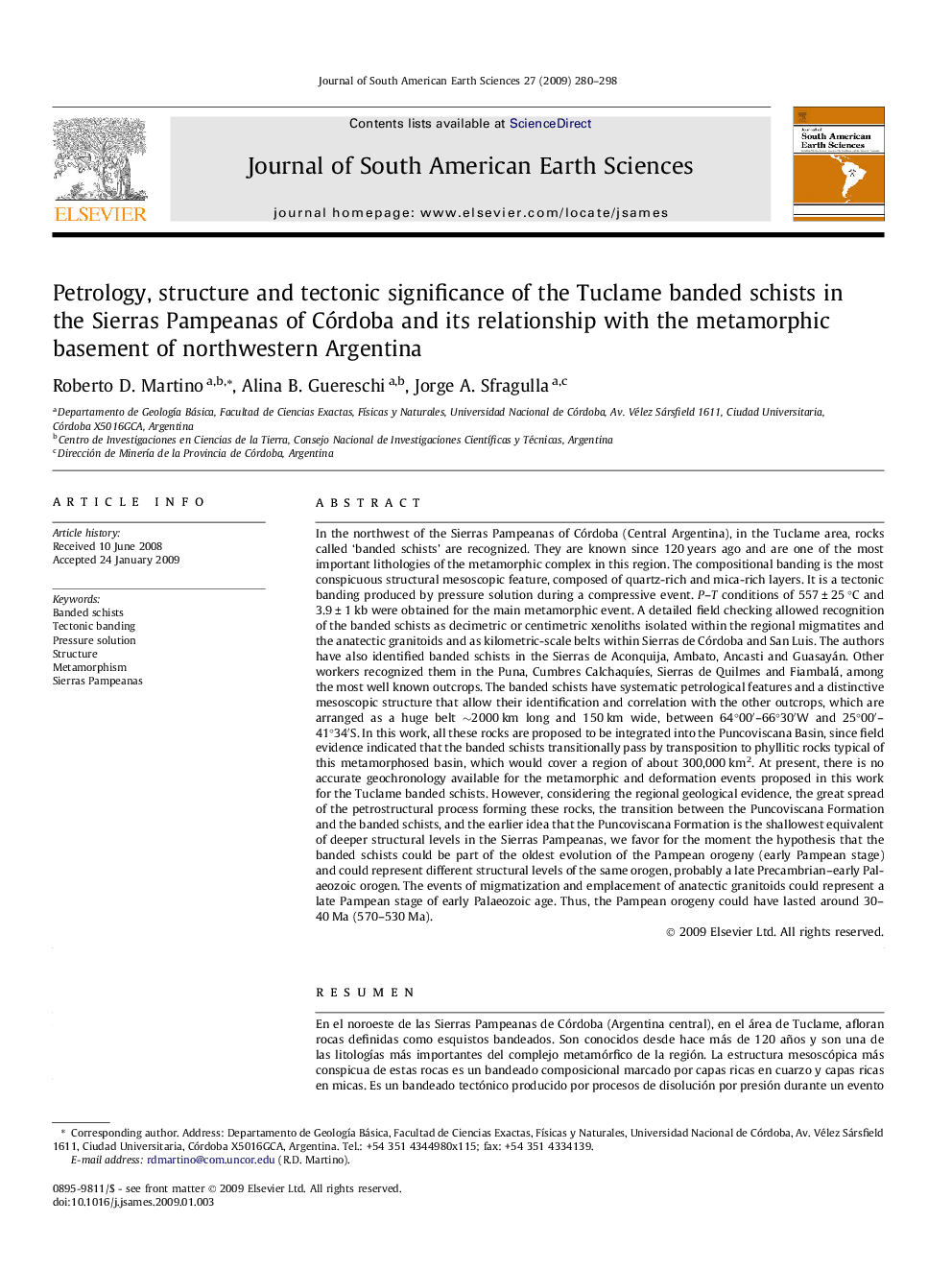| کد مقاله | کد نشریه | سال انتشار | مقاله انگلیسی | نسخه تمام متن |
|---|---|---|---|---|
| 4682733 | 1348939 | 2009 | 19 صفحه PDF | دانلود رایگان |

ResumenEn el noroeste de las Sierras Pampeanas de Córdoba (Argentina central), en el área de Tuclame, afloran rocas definidas como esquistos bandeados. Son conocidos desde hace más de 120 años y son una de las litologías más importantes del complejo metamórfico de la región. La estructura mesoscópica más conspicua de estas rocas es un bandeado composicional marcado por capas ricas en cuarzo y capas ricas en micas. Es un bandeado tectónico producido por procesos de disolución por presión durante un evento compresivo. Las condiciones del evento metamórfico principal fueron calculadas en 557 ± 25 °C de temperatura y 3,9 ± 1 kb de presión. Estas rocas fueron reconocidas como xenolitos decamétricos o centimétricos dentro de las migmatitas regionales y como fajas kilométricas en las Sierras de Córdoba y San Luis. También fueron reconocidos por los autores en las Sierras de Aconquija, Ambato, Ancasti y Guasayán. Otros autores los mencionan en la Puna, Cumbres Calchaquíes, Sierras de Quilmes y de Fiambalá. Las características petrológicas sistemáticas y la estructura interna distintiva de estas rocas permite su correlación e integración regional con afloramientos similares, disponiéndose a modo de una gran faja entre los 64°00′–66°30′ LO y 25°00′–41°34′LS, de aproximadamente 2000 km de largo y 150 km de ancho. En este trabajo, se propone integrar todas estas rocas en la Cuenca Puncoviscana, ya que existe evidencia de campo de que los esquistos bandeados pasan transicionalmente por transposición a rocas filíticas típicas de esta cuenca metamorfizada, la que abarcaría así una región de aproximadamente 300,000 km2. Hasta ahora, no se dispone de una geocronología precisa de los eventos metamórficos y de deformación propuestos en este trabajo para los esquistos bandeados Tuclame. Sin embargo, teniendo en cuenta las evidencias geológicas regionales, la gran extensión del proceso petroestructural generador de estas rocas, la transición entre rocas de la formación Puncoviscana a esquistos bandeados, la temprana idea de que dicha formación es el equivalente somero de afloramientos más profundos que representan las Sierras Pampeanas, hacen que nos inclinemos momentáneamente por la hipótesis de que los esquistos bandeados serían la evolución más antigua de la orogenia Pampeana (etapa Pampeana Temprana) y representarían distintos niveles estructurales de ese orógeno Precámbrico Tardío–Paleozoico Temprano. Los eventos de migmatización y emplazamiento de granitoides anatécticos representarían una etapa Pampeana Tardía del Paleozoico Temprano. La orogenia Pampeana habría durado así unos 30–40 Ma (570–530 Ma).
In the northwest of the Sierras Pampeanas of Córdoba (Central Argentina), in the Tuclame area, rocks called ‘banded schists’ are recognized. They are known since 120 years ago and are one of the most important lithologies of the metamorphic complex in this region. The compositional banding is the most conspicuous structural mesoscopic feature, composed of quartz-rich and mica-rich layers. It is a tectonic banding produced by pressure solution during a compressive event. P–T conditions of 557 ± 25 °C and 3.9 ± 1 kb were obtained for the main metamorphic event. A detailed field checking allowed recognition of the banded schists as decimetric or centimetric xenoliths isolated within the regional migmatites and the anatectic granitoids and as kilometric-scale belts within Sierras de Córdoba and San Luis. The authors have also identified banded schists in the Sierras de Aconquija, Ambato, Ancasti and Guasayán. Other workers recognized them in the Puna, Cumbres Calchaquíes, Sierras de Quilmes and Fiambalá, among the most well known outcrops. The banded schists have systematic petrological features and a distinctive mesoscopic structure that allow their identification and correlation with the other outcrops, which are arranged as a huge belt ∼2000 km long and 150 km wide, between 64°00′–66°30′W and 25°00′–41°34′S. In this work, all these rocks are proposed to be integrated into the Puncoviscana Basin, since field evidence indicated that the banded schists transitionally pass by transposition to phyllitic rocks typical of this metamorphosed basin, which would cover a region of about 300,000 km2. At present, there is no accurate geochronology available for the metamorphic and deformation events proposed in this work for the Tuclame banded schists. However, considering the regional geological evidence, the great spread of the petrostructural process forming these rocks, the transition between the Puncoviscana Formation and the banded schists, and the earlier idea that the Puncoviscana Formation is the shallowest equivalent of deeper structural levels in the Sierras Pampeanas, we favor for the moment the hypothesis that the banded schists could be part of the oldest evolution of the Pampean orogeny (early Pampean stage) and could represent different structural levels of the same orogen, probably a late Precambrian–early Palaeozoic orogen. The events of migmatization and emplacement of anatectic granitoids could represent a late Pampean stage of early Palaeozoic age. Thus, the Pampean orogeny could have lasted around 30–40 Ma (570–530 Ma).
Journal: Journal of South American Earth Sciences - Volume 27, Issue 4, April 2009, Pages 280–298